Related Research Articles

Fiber art refers to fine art whose material consists of natural or synthetic fiber and other components, such as fabric or yarn. It focuses on the materials and on the manual labor on the part of the artist as part of the works' significance, and prioritizes aesthetic value over utility.

Anni Albers was a German-Jewish visual artist and printmaker. A leading textile artist of the 20th century, she is credited with blurring the lines between traditional craft and art. Born in Berlin in 1899, Fleischmann initially studied under impressionist painter Martin Brandenburg from 1916 to 1919 and briefly attended the Kunstgewerbeschule in Hamburg in 1919. She later enrolled at the Bauhaus, an avant-garde art and architecture school founded by Walter Gropius in Weimar in 1922, where she began exploring weaving after facing restrictions in other disciplines due to gender biases at the institution.

Lenore Tawney was an American artist working in fiber art, collage, assemblage, and drawing. She is considered to be a groundbreaking artist for the elevation of craft processes to fine art status, two communities which were previously mutually exclusive. Tawney was born and raised in an Irish-American family in Lorain, Ohio near Cleveland and later moved to Chicago to start her career. In the 1940s and 50s, she studied art at several different institutions and perfected her craft as a weaver. In 1957, she moved to New York where she maintained a highly successful career into the 1960's. In the 1970s Tawney focused increasingly on her spirituality, but continued to make work until her death.
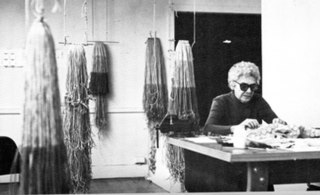
Claire Zeisler was an American fiber artist who expanded the expressive qualities of knotted and braided threads, pioneering large-scale freestanding sculptures in this medium. Throughout her career Zeisler sought to create "large, strong, single images" with fiber.
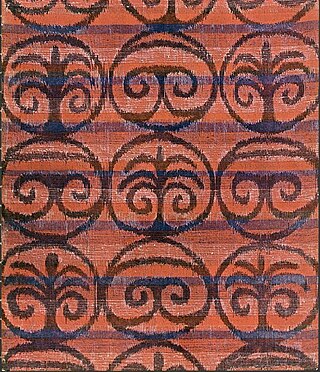
Ed Rossbach was an American fiber artist. His career began with ceramics and weaving in the 1940s, but evolved over the next decade into basket making, as he experimented playfully with traditional techniques and nontraditional materials such as plastic and newspaper.

Frans Wildenhain also known as Franz Rudolf Wildenhain was a Bauhaus-trained German potter and sculptor, who taught for many years at the School for American Craftsmen at the Rochester Institute of Technology in Rochester, New York.

Mary Lee Hu is an American artist, goldsmith, and college educator, known for using textile techniques to create intricate woven wire jewelry.
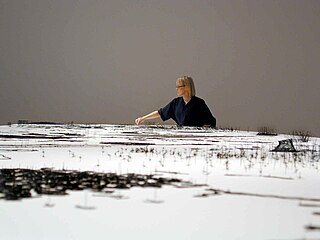
Anne Wilson is a Chicago-based visual artist. Wilson creates sculpture, drawings, Internet projects, photography, performance, and DVD stop motion animations employing table linens, bed sheets, human hair, lace, thread and wire. Her work extends the traditional processes of fiber art to other media. Wilson is a professor in the Department of Fiber and Material Studies at The School of the Art Institute of Chicago.

Mildred Constantine Bettelheim was an American curator who helped bring attention to the posters and other graphic design in the collection of the Museum of Modern Art in the 1950s and 1960s

Adela Akers was a Spanish-born textile and fiber artist residing in the United States. She was Professor Emeritus at the Tyler School of Art. Her career as an artist spans the "whole history of modern fiber art." Her work is in the Renwick Gallery, the Metropolitan Museum of Art and the Museum of Art and Design. Her papers are at the Archives of American Art.
Polly Barton is an American textile artist.
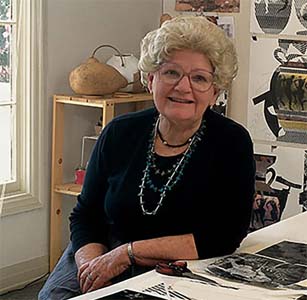
Katherine Westphal was an American textile designer and fiber artist who helped to establish quilting as a fine art form.

Marianne Strengell was an influential Finnish-American Modernist textile designer in the twentieth century. Strengell was a professor at Cranbrook Academy of Art from 1937 to 1942, and she served as department head from 1942 to 1962. She was able to translate hand-woven patterns for mechanized production, and pioneered the use of synthetic fibers.

Françoise Grossen is a textile artist known for her braided and knotted rope sculptures. She lives and works in New York City. Grossen’s work has been acquired by the Metropolitan Museum of Art, New York; the Renwick Gallery, Smithsonian American Art Museum, Washington, DC; and the State Hermitage Museum, Saint Petersburg, Russia.
Joan Livingstone is an American contemporary artist, educator, curator, and author based in Chicago. She creates sculptural objects, installations, prints, and collages that reference the human body and bodily experience.
Tracy Krumm is an American textile artist, craft educator, and curator based in St. Paul, Minnesota. Krumm's work combines metalworking and crochet; crafting items such as curtains and clothing out of metals and wire.
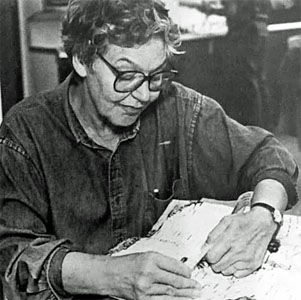
Lillian Wolock Elliott was an American fiber artist, and textile designer. She is known for her innovative basket craft.
Evelyn Svec Ward was an American fiber artist, she was known for her abstract textile work. She was influenced by Mexican handicrafts and Mexican traditional fiber. She worked at the Cleveland Museum of Art in the textiles department for almost 10 years, before embarking on her career as an artist.
Jane Gottlieb Sauer is an American fiber artist, sculptor, gallerist, and educator. She is known for her abstract waxed linen sculptures, sometimes referred to as "closed baskets". Saur founded the Textile Art Alliance; and formerly owned the Jane Sauer Gallery (2005–2013) in Santa Fe, New Mexico.
References
- 1 2 "Sherri Smith". American Craft Council . Retrieved 2024-03-25.
- ↑ Porter, Jenelle; Adamson, Glenn (2014). Fiber: Sculpture 1960-present. Institute of Contemporary Art, Boston and DelMonico Books/Prestel Publishing. ISBN 978-3-7913-5382-1.
- ↑ Rubinstein, Charlotte Streifer (1990). American Women Sculptors: A History of Women Working in Three Dimensions. G.K. Hall. p. 439. ISBN 978-0-8161-8732-4.
- ↑ "Masters: Sherri Smith". American Craft Council magazine. September 17, 2012. Retrieved 2024-03-26.
- ↑ "Sherri Smith". Art Faculty '75: An Exhibition of Works by the Art Faculty of the University of Michigan. University of Michigan Museum of Art. 1975. p. 7 – via Google Books.
- ↑ Retzer, John Porter (1986). Fiber R/evolution: Exhibition. Milwaukee Art Museum. p. 48 – via Google Books.
- 1 2 3 4 5 Heller, Jules; Heller, Nancy G., eds. (1995). North American Women Artists of the Twentieth Century. New York and London: Garland. p. 517. ISBN 978-1-135-63882-5 – via Google Books.
- 1 2 "Smith, Sherri". International Directory of Exhibiting Artists. Vol. 3. Clio Press. 1982. p. 274. ISBN 978-0-903450-61-4.
- ↑ Waller, Irene (1977). "Sherri Smith". Textile Sculptures. Studio Vista. p. 124. ISBN 978-0-289-70765-4.
- 1 2 "Sherri Smith". Minneapolis Institute of Art (MIA). Retrieved 2024-03-26.
- ↑ "Tengri". Fine Arts Museums of San Francisco (FAMSF). Retrieved 2024-03-26.
- ↑ "Sherri Smith". Smithsonian American Art Museum (SAAM). Retrieved 2024-03-26.
- ↑ "Sherri Smith". The Art Institute of Chicago. 1943. Retrieved 2024-03-26.
- ↑ "Untitled". RISD Museum. Retrieved 2024-03-26.